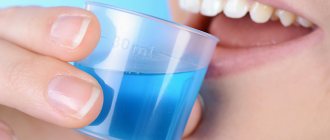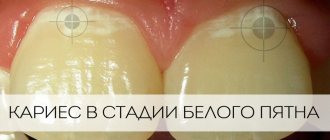Fissure caries is localized in the depressions located on the chewing surface of the teeth. Fissures have a complex structure, so they often accumulate food debris and bacteria, which cause carious lesions. We will talk about the causes, symptoms and methods of treating fissure caries in the article.
In this article
- Causes of fissure caries
- Symptoms of fissure caries
- Diagnosis of fissure caries
- Treatment of fissure caries
- Fissure caries in children
- Complications of fissure caries
- Prevention
Fissures are depressions and grooves located on the chewing surface of molars and premolars. They are grooved, cone-shaped and teardrop-shaped. In addition, they differ in depth and shape. These grooves are necessary for better chewing of food and even distribution of load across the jaw. If there were no fissures and the teeth were flat, they would often crack and split.
Food debris accumulates in the fissures, which causes the spread of bacteria. If a person has an incorrect bite or does not maintain good oral hygiene, he or she develops fissure caries.
What are dental fissures
Fissures are natural depressions in the form of grooves of different shapes and depths on the chewing surface of the teeth. During the chewing process, the grooves can become filled with food debris, which is quite difficult to remove with a regular toothbrush. As a result of their accumulation, an environment favorable for the occurrence of caries is formed.
There are several types of fissures:
- polyp-shaped - usually cleaned well with a brush;
- funnel-shaped - have wide edges, are freed from food debris with saliva;
- cone-shaped - food remains are difficult to remove;
- drop-shaped (deep) - trapped food debris rots and provokes the occurrence of caries.
One of the main features of fissures is that their depth can increase over time. Due to the influence of oral fluid, food debris, mechanical stress and decay processes, the gap widens and caries occurs.
To make it clearer. There is a significant difference between the fissures of newly erupted teeth and those of more “adult” teeth. The first ones are deeper and more tortuous, which is why they are so difficult to clean with a toothbrush. Given that the enamel of young teeth is immature and less durable, it becomes vulnerable to caries.
Important. A prerequisite for sealing is the complete and absolute absence of caries.
Why are fissures sealed?
Depressions localized in the area of small and large radical units are more likely than others to serve as a source of caries. The peculiarities of their shape (polyp-shaped, conical, funnel-shaped, drop-shaped, etc.) and size make it difficult to remove soft plaque with a regular brush. Moreover, the thickness of the enamel in the area of fissure elements is thinner than in the area of protruding tubercles. This makes the situation worse.
By sealing fissures, dentists prevent the appearance of “holes” and reliably protect patients’ teeth from destruction.
When is fissure sealing performed?
The procedure is recommended to be carried out in childhood immediately after teething as they appear. At this point, the enamel contains insufficient amounts of fluorine and calcium and continues to be mineralized due to the internal reserves of the body and external sources of microelements.
Tooth enamel is most vulnerable during its maturation period, which is why it is so important to protect it from pathogenic microflora during this period. Sealing fissures makes it possible not only to smooth the chewing surface, but to fill the grooves with plastic material. As a result, the weakest areas of the teeth are protected.
Dentists recommend performing the same procedure on baby teeth. Another question is that parents do not consider it necessary to protect the enamel at this age, guided by the opinion that the teeth will fall out anyway and there is no need to “bother” with it. For some reason, everyone forgets that baby teeth can also hurt and will have to be treated. And this is a completely different story.
The second point is that it is difficult to force such a small child to open his mouth and it is very difficult to fix his head in one position. The little one simply doesn’t understand and is afraid.
Treatment of fissure caries
Depending on the stage of the disease, dentists use the following methods for treating caries developing in the fissure area:
Fluoridation of enamel. The procedure is advisable at the first and second stages of carious lesions. The doctor remineralizes the enamel structure by saturating it with various minerals, primarily fluorine and calcium. To do this, a special composition is applied to the tooth, and for home use, therapeutic and prophylactic pastes, gels and rinses are prescribed: Biorepair Plus Total Protection, Dental Resources Inc Sorbet Revive, Biorepair Delicate Gums Mouthwash, etc. Fluoridation in the clinic is carried out several times a year, based on from the state of enamel.
Sealing of fissures. When treating the initial stage of fissure caries, fissure sealing can be done. They are sealed with a sealant using an invasive or non-invasive method. In the first case, the cavity is partially opened with a special tool, in the second, the visible pits are simply filled with the composition.
Filling. At the third and fourth stages, the tooth needs to be filled. The process of installing a filling begins with the administration of an anesthetic drug. After this, the doctor removes dead tissue, cleans the carious cavity, applies a protective lining and fills it with filling material. If there are complications, for example, pulpitis, the nerve is removed.
Why is fissure sealing needed?
The main goal of the procedure is to seal the grooves with a sealant and allow the tooth to mineralize. The natural strengthening of enamel does not take place in one year, so it is so important to ensure its protection during this time and prevent caries from damaging the tooth cavity.
Creating a mechanical barrier prevents food debris from getting into the fissures, while significantly reducing the risk of pathogenic flora settling on the enamel. Sealing initially involves the prevention of caries, and not its blocking.
Important. Measures taken in time will allow you to subsequently preserve the molars, which bear the main chewing load. First of all, we are talking about the so-called “six”, which, according to statistics, suffers more than other teeth.
Modern sealing methods
Dentists have been trying to solve the problem of fissure sealing for quite some time. Just a few years ago, sealing of grooves was carried out using zinc-phosphate compounds, mechanical excision of fissures, and chemical treatment with silver nitrate were used.
With the advent of new composite materials with a high degree of adhesion, they began to be used to prevent caries. The so-called sealants provide good sealing of fissures, completely eliminating the penetration of air, water, food residues along with pathogenic flora. The aesthetic component is no less important - the compositions on the teeth are almost invisible.
Modern technologies provide for the use of two types of composite sealants - transparent and colored, including white. Transparent compositions are applied in cases where there is a high probability of caries occurring after the procedure. The colored polymer allows you to monitor the integrity of the coating in order to restore it in time if necessary.
There are two methods of fissure sealing - non-invasive and invasive. The doctor chooses the method of dental treatment based on the examination and condition of the little patient’s teeth.
If the fissure is completely visible and there are no traces of caries damage on the walls and bottom, the doctor uses a non-invasive technique, that is, the procedure is carried out without opening the enamel. The doctor gradually treats the surface of the teeth and applies sealant.
If the fissures have narrow and deep grooves, the doctor cannot determine whether the hidden surfaces are affected by caries. In this case, we are talking about the use of an invasive method, that is, the use of a drill. After expanding the grooves, the doctor has the opportunity to examine the fissure cavity and make a decision - to continue sealing or treat caries.
Important. In the remaining voids that are not filled with a composite, caries may begin to develop, which will destroy the tooth from the inside. This is why a good view of all fissure surfaces is so important.
Stages of fissure sealing
The invasive and non-invasive sealing methods differ in only one aspect - the expansion of the fissure (usually painless). Parents should understand that using a drill will not harm their child.
All subsequent steps are identical for both methods:
- preparatory – includes cleaning the tooth from plaque and food debris with a special brush or Air Flow, treatment with an antiseptic and drying with warm air;
- treatment of enamel with acid - carried out in order to improve adhesive properties and better adhesion of the surface to the filling compound, then rinsing with water and drying with air;
- directly applying the sealant and hardening it under the light of a polymerization lamp;
- the final step is removing excess sealant and polishing the hardened composition.
The last step is that the doctor applies a fluoride-containing varnish to the “corrected” tooth, which provides protection and additional nutrition to the enamel.
Materials used during the procedure
When closing fissure grooves, doctors usually use sealant, a high-strength modern composite. It is fluid and easily penetrates even into hard-to-reach areas of the dental crown. The composition does not allow moisture to pass through and is not destroyed by saliva, drinks, or food. Its service life is from three to five years.
Other composite products are used if the fissures are narrow and extend deep into the crown. To reduce the likelihood of hidden caries, the doctor expands them slightly and immediately fills them with a medicinal substance.
If the patient's enamel is very weak and poorly mineralized, glass ionomer cements may be used. They contain fluoride in active form, which is able to gradually penetrate into the deepest layers of enamel. In this way, double prevention of carious destruction is achieved - the enamel is “fed” with fluoride for a long time, and the outside of the crown is covered with a sealant.
What does the sealant consist of?
Preparations used to seal fissures are divided according to the type of hardening into chemical and light-curing. Dentists prefer to use compounds that polymerize under the influence of a special lamp.
The applied polymers are a gel-like material placed in a special syringe at the production stage. The flowing material fills the fissures and hardens under the influence of a light lamp.
The preparations contain active fluoride ions, which penetrate the tooth enamel and promote its rapid mineralization. Most often, doctors use Fissurit F (with a NaF concentration of 3%) and Grandio Seal, which are particularly durable and have low shrinkage.
Fissure sealing in children: pros and cons
The fissure sealing technique, oddly enough, has its opponents. Some dentists claim that the hardened composition interferes with the normal development of the tooth and prevents it from forming correctly. Also, a clearly technological issue is included among the minuses, if suddenly part of the fissure is left unfilled with sealant (we are talking about the doctor’s qualifications, which has nothing to do with the properties of the polymer).
Scientists who have developed gel-like compositions for sealing fissures confirm in practice that the hardened polymer has elasticity and plasticity. This means that it stretches as the tooth grows and strengthens.
The main advantage of the sealing procedure is the ability to avoid caries on the chewing surface of the tooth. During the time that the fissures are mechanically protected by the filling compound “from above,” the enamel mineralizes to such an extent that it begins to actively resist pathogenic microflora.
Add to this the painlessness of the manipulation - in good clinics, where many distractions have been invented for children, a visit to the doctor will not be accompanied by the child’s uncontrollable tears and the mother’s sighs.
Important. To make the right decision, remember how much a tooth can hurt. Probably, there is no need to give any other arguments...
Price
The sealing procedure is a paid service. The cost of the procedure depends on the type and depth of the fissures, the sealing method, and the use of a specific drug.
The standard price can range from 800 to 1500 rubles. This is not an amount that will blow your budget. Moreover, each tooth is done at a separate visit to the dentist.
Compared to how much you can spend on the treatment of caries/deep caries/pulpitis, such expenses can not be taken into account at all.
Complications of fissure caries
The most common complication of any caries is pulpitis - inflammation of the soft tissues located inside the tooth. The disease is accompanied by acute pain, which cannot be relieved by painkillers. A carious lesion, if left untreated, can cause periodontitis - an inflammatory pathology of the ligamentous apparatus that holds the tooth root in the alveolus. Caries can also lead to infection of bone tissue.
If caries is not treated at all, the tooth can be completely destroyed. It will have to be removed, and installing implants is an expensive treatment that is not affordable for everyone.
Indications for the procedure
The main indicator of the need for a procedure in children or adults is deep fissure canals that require special cleansing. In this case, conventional hygiene products may not be able to remove food debris.
The second reason for turning to specialists is the presence of a rough surface of the tooth. Microscopic particles of food will be retained on such “clingy” enamel, and it is also more susceptible to penetration of pathogenic flora. Over time, such tooth tissue softens and breaks down.
The most important reason to go to the dentist is the eruption of the first six teeth. The doctor must look at the condition of the tooth and tell whether it needs additional strengthening.
Important. If you notice that the surface of your baby’s tooth has a large number of irregularities (grooves, bumps, tubules), do not let it get to the point of caries. Sign up for a consultation. Perhaps this is your case.
Prevention
Every six months a person should come to the dentist for a preventive examination, even if he is not bothered by any symptoms. Also, to prevent the development of caries, it is recommended:
- brush your teeth at least twice a day;
- rinse your mouth after every meal;
- use mouth rinses;
- carry out additional cleaning of teeth with an irrigator;
- stop smoking;
- eat less sweets.
Dental treatment is expensive, so it is better to make every effort to avoid dental diseases. When the first signs of caries appear, consult a doctor immediately.
Contraindications
The fissure sealing procedure is not recommended for all children. Only the doctor determines the need to seal the canals.
The list of contraindications includes:
- the presence of caries on the chewing surface or in the interdental (approximal) space;
- free fissures with a good intact structure - intact and easily cleaned naturally;
- good fissure resistance to caries for four years.
In all these cases, sealing is not required.
Content:
- Why are fissures sealed?
- Indications
- Contraindications
- How to seal fissures
- Materials used during the procedure
- After the procedure
- Benefits of the procedure
The most convenient place for the accumulation of food debris and the proliferation of pathogenic bacteria in the human oral cavity is dental fissures.
What it is? We are talking about the natural depressions present on the surface of every person’s chewing teeth. To extend the life of molars and premolars, dentists perform an effective procedure - sealing. Let's consider what it includes, how it goes and what results it allows to achieve.











